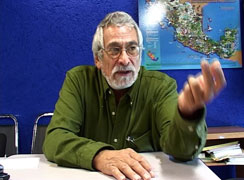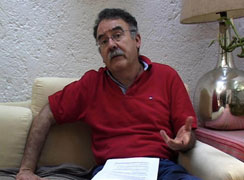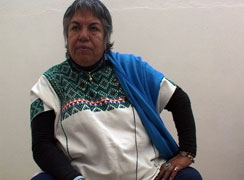Home / / Photo / Sculptures / Curatorial Projects / Bio / Contact
"Die Erinnerung ist nur eine Dimension, an der die Arbeit von Heidrun Holzfeind ansetzt. Sie lässt die damaligen Aktivistinnen und Aktivisten selbst zu Wort kommen und bedient sich dabei der unterschiedlichen künstlerischen Techniken wie der wissenschaftlichen Recherche, der Aufzeichnung, der Archivierung und der Dokumentation und knüpft mit diesen an die Debatten um die Aktualisierung dieser künstlerischen Mittel an. In der Sicht der Beteiligten der mexikanischen 68er-Bewegung wird diese Geschichte nicht nur wach gehalten, sondern auch neu geschrieben. Und zwar in einem doppelten Sinne: So wie jede Erzählsituation einen neuen Zusammenhang darstellt und andere Schwerpunkte in der Erzählung hervorbringt, birgt auch jede Rezeptionssituation neue Erfahrungen – und Kontexte.” (Jens Kastner, in: Moderne, Modernismus, Modernisierung, dérive Nr 31, 2008)
![]()

![]()

![]()

>stills and quotes
>installation views
>68 archive photos
>reviews
![]()
![]()
![]() "The way in which Holzfeind deploys the documentary project does not rule out an emotive approach; rather, it returns it to the very actors of the student movement. From the present, these very actors evaluate and weigh out the personal and social repercussions of their participation in the movement. Holzfeind's project undeniably demands a degree of attention and discipline from the public far from that demanded by many works of contemporary art related to historical reflection. But the effort of paying attention to the totality of interviews and other documents allows one to experience a "retrospection" of Mexico's 1968, in a fashion closer to the horizon of human relations – a horizon that admits the paradox, complexity and problematization of relationships between individuals and their world.” (Jorge Reynoso Pohlenz)
"The way in which Holzfeind deploys the documentary project does not rule out an emotive approach; rather, it returns it to the very actors of the student movement. From the present, these very actors evaluate and weigh out the personal and social repercussions of their participation in the movement. Holzfeind's project undeniably demands a degree of attention and discipline from the public far from that demanded by many works of contemporary art related to historical reflection. But the effort of paying attention to the totality of interviews and other documents allows one to experience a "retrospection" of Mexico's 1968, in a fashion closer to the horizon of human relations – a horizon that admits the paradox, complexity and problematization of relationships between individuals and their world.” (Jorge Reynoso Pohlenz)
read full text in > English or > Spanish
read full text in > German
or excerpts in > English
"Roberto Bolano's "The Savage Detectives" (1998) tells the story of the two literati Ulises Lima and Arturo Belano. The second part of the book is conceived as a sequence of first-person narratives. in the sixth section, for instance, Auxilio Lacouture tells about surviving the crushing of the Mexican student movement in 1968, or more precisely the brutal invasion of the military into the university grounds in Mexico City, by hiding for days in a ladies' restroom at the Faculty for Literature and Philosophy.
Heidrun Holzfeind's eighteen differently long videos, conjoined into "Mexico 68", also deal with the story of the student movement in Mexico, its development, the history of its socio-political impact up to the present, which is important especially for the university context, but also the individual fates connected with this history. Unlike Bolano's stories, though, these are not of a fictive nature, but rather claim in the sense of oral history to be factual reports. In the conversations that were conducted between 2005 and 2007 with Heidrun Holzfeind in Mexico in front of a camera, there is talk of the role of women, who mostly operated in the background, of complicity with the working class, and again and again of the imprisonment of various participants.
Nevertheless, "Mexico 68" with its "talking heads" filmed frontal is not a purely documentary work. Its sometimes very private and emotional moments and the uncommented film segments structured only through keyword inserts—such as "The Role of Women", for example—make it a hybrid work; its political power of persuasion and aesthetic quality consist of the combination of just representing and being presumably not composed.
An archive consisting of twentysix black and white photographs primarily showing the demonstrations and documenting the course of events complete the work "Mexico 68". This extensive work is occasionally flanked by two further works: the slide installation "CU (Mexico City, August 2006)" (2007) and six drawings with the title "Their Truth Is Not Ours" (2007). The former consists of 120 slides depicting the (architectural) state of the university campus in 2006. In the drawings "Their Truth Is Not Ours"—the title of which is a quotation from the Russian revolutionary and author Victor Serge, referring to the Other, the excluded, being an outsider—the artist transposes motifs of leftist rhetoric into drawings. The battle with the law, for instance, over "their" truth and "ours" is given a face in the form of a club-swinging monster.” (Raimar Stange, excerpt from: On the Inside of the Outside(r.) 4 Fragments. Camera Austria Nr 113, 2011)
read text in > German